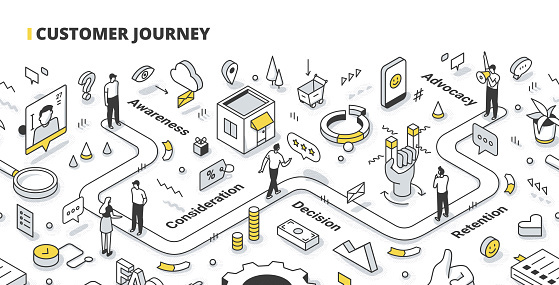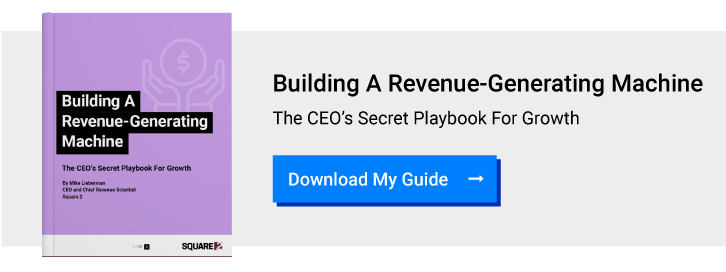
Jump-Start Growth By Focusing On Your Prospects’ Buyer Journeys
Digital Transformation Drives Revenue When You Make It ALL About Your Prospects
One of the most common reasons people list for failing to start strategic and transformative initiatives like going in on digital is that they don’t know where or how to get started.
We’re going to solve this right now. The easiest way to begin a digital transformation initiative is to start mapping and documenting every touch point in your prospects’ buyer journeys and then continuing that process of mapping the journey after they become a customer.
If you look at this journey from their perspective and view your company through their eyes, you’ll have everything you need to take this effort all the way through to completion.
If I asked 100 CEOs to show me their buyer journey map, 99 of them wouldn’t be able to produce the map. That’s a big problem and a significant contributor to slow or no revenue growth.
This is the first step to producing sustainable, predictable and repeatable revenue growth, and while this might seem like a daunting task, even the longest journey starts with a single step.
Engage Your People To Do This Correctly
When we work with clients on this, we recommend a cross-functional team that represents the prospects and the customers – someone (or a few people) from sales, marketing and customer service.
Everyone needs to agree that there are no bad ideas. All input is welcome, with honest and candid feedback mandatory. If you’re not honest about prospects’ and customers’ experiences, you’re dead in the water. Honesty and direct feedback are critical to your success.
Now bring a prospect/customer buyer journey framework to the group. This is the structure you’ll use to work through each stage of the buyer journey and map out every touch point, relating it back to the prospect/customer and how they feel about the experience you’re delivering.
We created our own framework for clients, the Cyclonic Buyer Journey™ framework, but there are many frameworks to use and many ways to work through this with your team.
While you’re mapping out every touch point, consider this: You might have heard the phrase “solve for the customer.” When you get into discussions about each stage and every touch point, continue to ask your team and challenge them.
- What would the customer (or prospect) want us to do here?
- How could we exceed their expectations?
- How can we proactively build peaks into their experiences with us?
- How can we continually get them to say, “Wow, this company is amazing”?
The more peaks, the more little wows and the more memories you create, the more stories your customers and prospects will remember and the more they’ll talk about your business, driving new and excited people to your doorstep.
Before we move on, let’s just be clear on some of the touch points we’re talking about. Here’s a partial list of some obvious and some more interesting touch points we’ve uncovered during buyer journey workshops with clients.
 Marketing Touch Points
Marketing Touch Points
Your website is going to be responsible for a number of touch points. The homepage is probably the most obvious, but others include secondary website pages, landing pages, blog articles, forms people might be asked to fill out, confirmation pages after they fill out a form and all of the content they consume on your site. These are all separate touch points.
Any email you send them, whether it’s a nurture post-form-fill, a general email or a blog notification email, is a touch point.
Any interactions they have with you across your social platforms are touch points. Your company pages, your individual pages, your content on social, any comments or engagement on your social pages and any ads you might be serving up on social platforms are all touch points.
Sales Touch Points
How your prospects engage with sales is going to be the first of many sales-related touch points. If they call in, how are they treated? Is the call directed immediately to a sales rep? Is the rep available or are they getting their voicemail?
Do they fill out a form? How long is the form? What page do they see after they fill out the form?
Can they chat with sales? What is that experience like? Do they get a link to schedule a meeting or are your reps going back and forth via email to schedule that first call?
If this is a burdensome effort, prospects are going to be frustrated, anxious and turned off.
What happens next? Does the rep push products and/or services? What is that first call designed to do for the prospect? How long is it? What does the script look like? What’s the objective of that first prospect call with a rep? This first call almost always dictates whether there will be a second call.
Usually, there are a number of calls along the way during the sales process. Of course, these are touch points, but so is every email the rep sends, every link the rep provides a prospect and every piece of content the rep sends.
Each of these touch points needs to be designed to move the prospect forward while helping them get to know, like and trust your reps and your company. This is a very deliberate and strategic set of steps. The experience should be designed like Disney designs the experiences associated with each of their rides.
Finally, as the prospect gets close to signing, the touch points might get a little more significant. The reference calls, the process of getting references, the contract, the signing process and any negotiations – these are all touch points that need to be looked at and designed to deliver those little wow experiences.
If you can do this, you’ll shorten the sales process and increase your close rate, guaranteed.
Customer Service Touch Points
Last but not least, after your prospects have signed and become customers, more experiences need to be mapped out and designed strategically.
If your customers are not getting a wow experience as customers, they won’t talk about your business. That means no word-of-mouth marketing, no buzz in the community, no referrals, no reviews, no references and no success stories. The result is your Revenue Cycle grinds to a halt.
Here are some customer-centric touch points to work on.
How you deliver your services is vital, and there are a ton of touch points around delivery. How closely does your delivery experience match what was shared in the sales process? It needs to match perfectly.
Do you deliver on time? What does the communication around delivery look like? Is it proactive? Is it clear? Is it the right amount?
How do you handle invoicing and how do you follow up on delayed or late payments? These are touch points, like it or not. How you handle these touches with customers does contribute to their experience.
How do you cross-sell or try to upsell? How do you engage your prospects to participate in your advocacy marketing efforts? How do you ask them to be a reference? How do you check in to see how they’re doing? How do you resolve issues they might have? These are all touch points that can make or break the story they tell about your organization.
When you’re done mapping out every prospect and customer touch point, now you’re ready to start working on ways to improve each of those touch points. Use digital tools to automate and personalize as much as possible.
This is going to uncover that you need data, a CRM platform and the right tools to start creating the peaks or little wow moments for your prospects and customers.
These changes will have game-changing impacts on your business. But installing these upgrades will take time, persistence and a commitment to digitally transforming your business for the better.
In upcoming articles, we’ll dig deeper into the marketing, sales and customer service upgrades required to deliver a truly remarkable experience to today’s buyers.

CEO and Chief Revenue Scientist
Mike Lieberman, CEO and Chief Revenue Scientist
Eliminate Hit-or-Miss Marketing Moves
Get advice, tips, tools and guidance to generate more leads for your company in this weekly email newsletter.



Eliminate Hit-or-Miss Marketing Moves
Get advice, tips, tools and guidance to generate more leads for your company in this weekly email newsletter.













